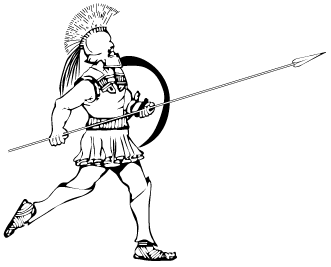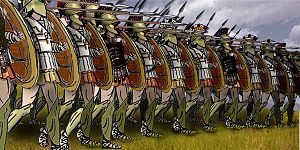 The Ancient Greeks went through their dark age in the years leading up to the 8th century BC. After the 8th century BC until the 6th century AD this period can be classed as the Ancient Greek period of history. This is a period of interesting wars and advances in warfare.
The Ancient Greeks went through their dark age in the years leading up to the 8th century BC. After the 8th century BC until the 6th century AD this period can be classed as the Ancient Greek period of history. This is a period of interesting wars and advances in warfare.
The Ancient Greeks were well known for their warfare, you only have to think of the films Alexander, Troy and 300 to find out the world renowned stories of Greece in battle.
Today you are going to find out about the major Ancient Greek wars and the impact they had on the advance of civilisation and war as we know it.
The Greco-Persian Wars
Of all the wars this is probably the most well known, not so much for the war itself but more for some of the famous battles within.
The Greco-Persian Wars occurred between 499 BC and 448 BC. The wars occurred because the Persians through the leader Darius the Great and his son Xerxes I wished to take control of the Greek lands and bring them within the Persian Empire.
The war was said to start when the people of the Greek Ionian cities started an uprising against the Persian Darius the Great who had been controlling the cities for a while.
Within 5 years of the uprising Darius had crushed the rebellion and resolved to take the whole of Greece under the bosom of Persia. Darius sent his troops and commanders on a mission to attack Greece; initially they burned the eastern Eretria region of Greece before setting sale and landing troops at Marathon.
Here at Marathon an army of Athenians and Plataeans numbering 10,000 faced an army of up to 60,000 Persians. In the ensuing battle the Greek hoplites (heavy infantry) annihilated the Persian army to win the battle. It is said that the Greeks lost fewer than 200 men yet killed 6,400 Persians.
Ten years after this battle the Persians returned to attack Greece, this time through Xerxes some ten years after the first attacks.
This second invasion saw a mass of around 200,000 Persian soldiers march on Greece. It is here that the first battle occurred, the infamous Battle of Thermopylae where the Spartan warrior King Leonidas made his stand with his 300 against the Persian horde. The battle finished a Persian victory but at a cost of 20,000 men to the Greek 1,000 or so.
After the Battle of Thermopylae the Persians moved on to take Greece and a massive Naval battle occurred at the battle of Salamis where a smaller Greek navy of around 378 ships beat a strength of 600-800 Persian ships.
The Persians managed to finally repel the second Persian invasion and thus set about their own attack where the Greeks sailed across the sea to Byzantium (western region of present day Turkey) and besieged the region before finally taking control.
After this the Greeks continued to harass the Persians in the region of present day Turkey before the Athenians were decimated by the Persians and they withdraw to Greece. In 451 BC peace was agreed between Persia and Greece.

The Peloponnesian War
The Peloponnesian War was an internal Greek conflict that happened between 431 BC and 404 BC. This was between the Peloponnesian leagues led by Sparta facing the Athenian Empire.
The initial opening of the war was known as the Archidamian War and saw Sparta making continuous raids into Attica. At the same time Athens was using its Navy to make raids in to the Peloponnese to stop unrest. While this part of the war not so much pitched battles it did have a big impact in Greece, this opening part of the war ceased in 421 BC when the Peace of Nicias was agreed.
Six years later the treaty became null and void when Athens continued to raid the Peloponnese. At this same time the Athenians sent a large force to Sicily in a move to attack Syracuse, this move was disastrous for the Athenians as their whole force was demolished.
The final phase of the battle between 413 BC and 404 BC saw Sparta gain support of Persia in using rebels in Athenian territories to create an uprising further causing unrest and difficulties for Athens. Everything came to a head in 405 BC when the joined forces of Sparta, Persia and the Peloponnesian leagues sent a Naval force against the Athenians.
This was the Battle of Aegospotami, a battle of the high seas that saw 180 Spartan led ships obliterate 170 ships of Athens. The battle finished with the Spartan led forces losing hardly any ships while the Athenians lost 150 ships and had 3,000 sailors executed.
The outcome of the Peloponnesian War was that Athens moved from being the primary power in Greece to being almost ruined while Sparta became the new power of the Greek states.
Corinthian War
Between 395 BC and 387 BC the Corinthian War occurred. Rather than being an external war this was a war between the Greek states, in fact it was a war between Sparta and a combined force of Thebes, Athens, Corinth, and Argos states.
The war occurred because the other states of Greece were unhappy with the Spartan aim at expanding their control overseas.
It was Thebes that brought about the war, but they did not physically go to war until they were able to gain support from allied states.
When the war did start the Spartans won the initial battle, this was the Battle of Nemea. Next was the Battle of Cnidus which was a sea battle which the Spartans lost. The Battle of Coronea in 394 was next and this resulted in another Spartan victory.
After 394 the battles became skirmishes for a long time. This was because it became widely known that the Spartans were hard to defeat on land but the Spartans were easily beaten at sea so a stalemate occurred.
Because the Greek allied states were being supported by Persia the Spartans started a lot of successful raids on Persian territory, this really put the wind up the Persians.
In 387 BC Persia dictated the peace process that ended with the Peace of Antalcidas. The was finished as an inconclusive stalemate but it seems that Sparta and Persia were the ones to win overall with land gains and control.

